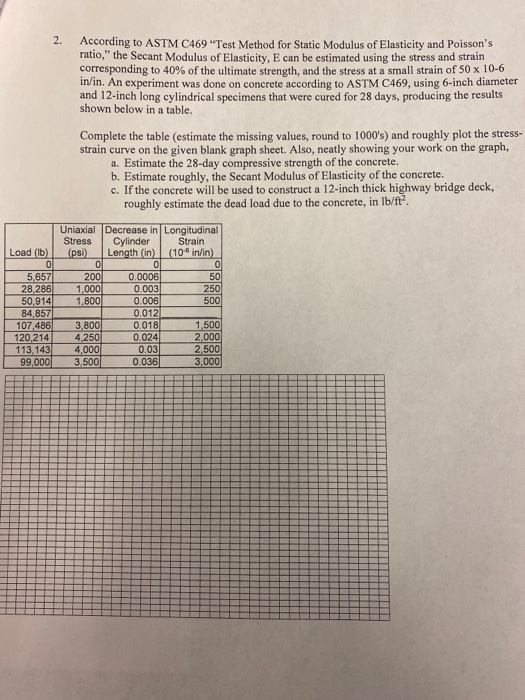Answered step by step
Verified Expert Solution
Question
1 Approved Answer
Load (lb) 0 5,657 28,286 50,914 2. 84,857 107,486 According to ASTM C469 Test Method for Static Modulus of Elasticity and Poisson's ratio, the

Load (lb) 0 5,657 28,286 50,914 2. 84,857 107,486 According to ASTM C469 "Test Method for Static Modulus of Elasticity and Poisson's ratio," the Secant Modulus of Elasticity, E can be estimated using the stress and strain corresponding to 40% of the ultimate strength, and the stress at a small strain of 50 x 10-6 in/in. An experiment was done on concrete according to ASTM C469, using 6-inch diameter and 12-inch long cylindrical specimens that were cured for 28 days, producing the results shown below in a table. Complete the table (estimate the missing values, round to 1000's) and roughly plot the stress- strain curve on the given blank graph sheet. Also, neatly showing your work on the graph, a. Estimate the 28-day compressive strength of the concrete. b. Estimate roughly, the Secant Modulus of Elasticity of the concrete. c. If the concrete will be used to construct a 12-inch thick highway bridge deck, roughly estimate the dead load due to the concrete, in lb/ft. Uniaxial Decrease in Longitudinal Stress Cylinder Strain (psi) Length (in) (10* in/in) 0 0 200 1,000 1,800 3,800 4,250 120,214 113,143 4,000 99,000 3,500 0.0006 0.003 0.006 0.012 0.018 0.024 0.03 0.036 0 50 250 500 1,500 2,000 2,500 3,000
Step by Step Solution
★★★★★
3.49 Rating (152 Votes )
There are 3 Steps involved in it
Step: 1
A Uniaxial Decrease in Longitudinal Stress psi Load lb 0 5657 Cylinder Length in 200 00006 Strain 10 ...
Get Instant Access to Expert-Tailored Solutions
See step-by-step solutions with expert insights and AI powered tools for academic success
Step: 2

Step: 3

Ace Your Homework with AI
Get the answers you need in no time with our AI-driven, step-by-step assistance
Get Started


